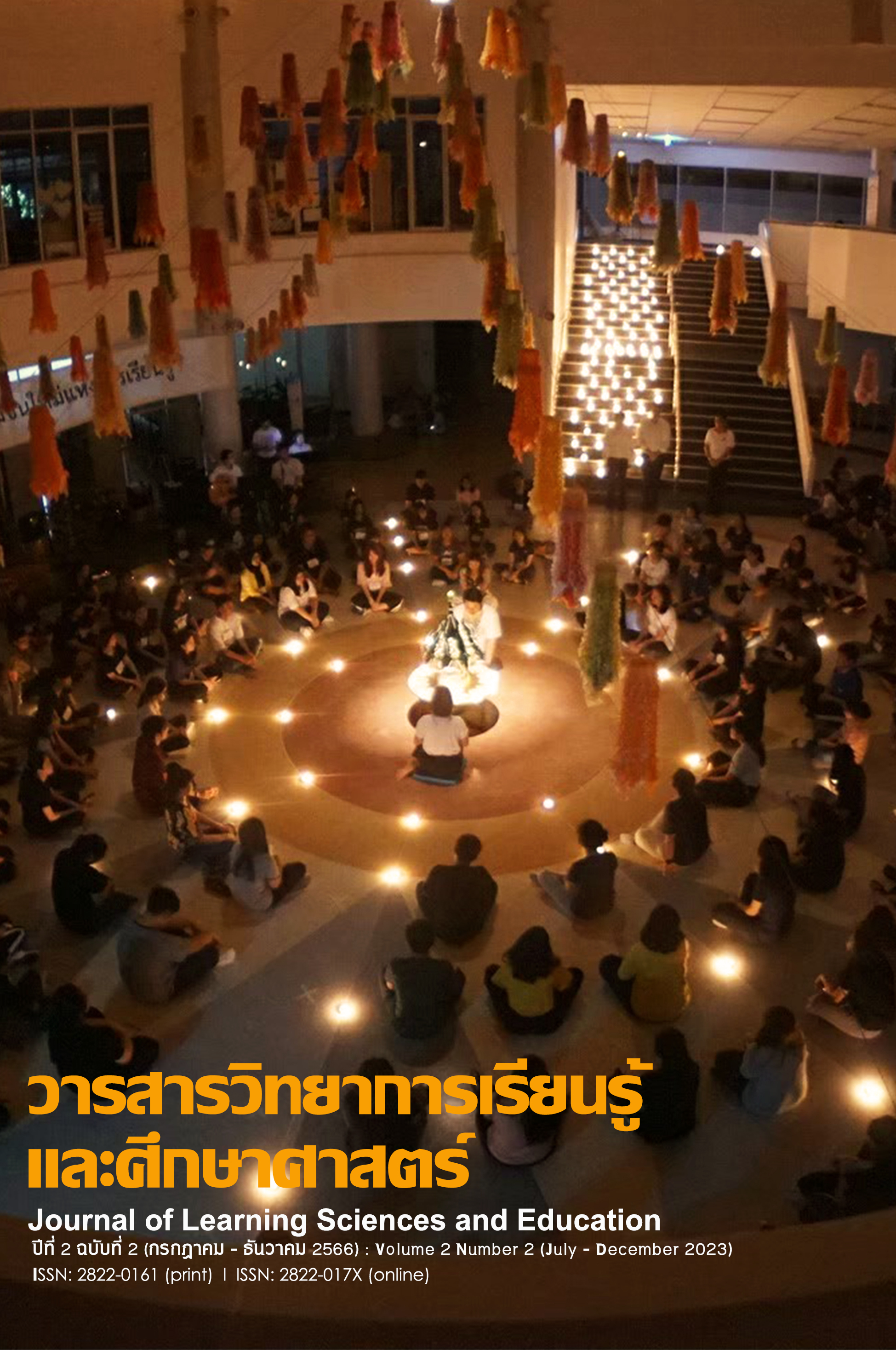ภายใต้ระบอบแห่งภาพลักษณ์และความกลัว: มายาคติเกี่ยวกับการเรียนรู้เรื่องเพศในพื้นที่การศึกษาของประเทศไทยและบทบาทที่หล่นหายของโรงเรียนไทยในการเรียนรู้เรื่องเพศ
Main Article Content
บทคัดย่อ
เพศศึกษา (Sex Education) และการทำความเข้าใจเกี่ยวกับเรื่องเพศในด้านต่าง ๆ ในสังคมไทยเป็นประเด็นใหม่ที่ท้าทายวงการการศึกษาในปัจจุบัน เป้าหมายพื้นฐานของการเรียนรู้เรื่องเพศคือการสร้างเสริมให้ผู้เรียนรับรู้เพื่อเท่าทันเรื่องเพศ มีมุมมองเชิงบวกต่อเรื่องเพศ และนำไปปรับใช้ในชีวิตประจำวันได้ แต่กลับพบว่าการสื่อสารเรื่องเพศในสังคมไทยเป็นประเด็นที่ถูกจำกัดและหลีกเลี่ยงการสื่อสารในพื้นที่สาธารณะ สถานศึกษาในฐานะ “พื้นที่การเรียนรู้” ยังถูกคาดหวังจากสังคมให้ทำหน้าที่บ่มเพาะผู้เรียนให้เกิดความเข้าใจเรื่องเพศภายใต้กระบวนทัศน์ที่สัมพันธ์กับเรื่องศีลธรรมอันดีงาม ยิ่งไปกว่านั้น ในพื้นที่โรงเรียน การเรียนรู้เกี่ยวกับเรื่องเพศของเยาวชนไทยก็ยังอยู่ในสภาวะ “หลบ ๆ ซ่อน ๆ” มาอย่างยาวนาน
บทความวิจัยนี้ เป็นการวิจัยเชิงสหวิทยาการ (Multidisciplinary Research) ผสานกรอบแนวคิดด้านสังคมศาสตร์กับประสาทจิตวิทยาเข้าไว้ด้วยกัน โดยใช้วิธีการวิเคราะห์วาทกรรมเชิงวิพากษ์ (Critical Discourse Analysis) รวมทั้งสำรวจความพึงพอใจและทัศนคติต่อการเรียนรู้เรื่องเพศ โดยมีวัตถุประสงค์ เพื่อ 1) สำรวจมายาคติเกี่ยวกับการเรียนรู้เรื่องเพศในโรงเรียนไทย และ 2) ศึกษาผลกระทบของมายาคติเกี่ยวกับการเรียนรู้เรื่องเพศที่มีต่อสุขภาวะของครูและนักเรียนในระบบการศึกษาของไทย ทั้งนี้ นักวิจัยใช้แนวคิดเรื่องระบอบแห่งภาพลักษณ์ (Regime of Images) และวัฒนธรรมแห่งความกลัว (Culture of Fear) มาร่วมอธิบายมายาคติเกี่ยวกับการเรียนรู้เรื่องเพศในโรงเรียน
ผลการศึกษาพบว่า โรงเรียนยังเป็นพื้นที่ไม่ปลอดภัยสำหรับการทำความเข้าใจเรื่องเพศสำหรับครูและนักเรียนอย่างถูกต้อง อีกทั้ง การปิดกั้นการเรียนรู้เรื่องเพศซึ่งอาจมีสาเหตุจากความพยายามในการรักษาภาพลักษณ์ของโรงเรียน สามารถส่งผลกระทบต่อความสัมพันธ์ระหว่างบุคคลภายในโรงเรียน ข้อค้นพบจากการวิจัยครั้งนี้เป็นการส่งสัญญาณถึงความจำเป็นในการปรับเปลี่ยนทัศนคติและบทบาทของโรงเรียนเกี่ยวกับการเรียนรู้เรื่องเพศต่อไป
Article Details

อนุญาตภายใต้เงื่อนไข Creative Commons Attribution-NonCommercial-NoDerivatives 4.0 International License.
เอกสารอ้างอิง
Agardh, A., Cantor-Graae, E., & Östergren, P. O. (2012). Youth, sexual risk-taking behavior, and mental health: a study of university students in Uganda. International journal of behavioral medicine, 19, 208-216.
Bernal-Morales, B., Rodríguez-Landa, J. F., & Pulido-Criollo, F. (2015). Impact of anxiety and depression symptoms on scholar performance in high school and university students. A Fresh Look at Anxiety Disorders, 225.
Blommaert, J., & Bulcaen, C. (2000). Critical Discourse Analysis, Annual Review of Anthropology, 29, 447-466.
Diaz-Bone, R., Bührmann, A. D., Rodríguez, E. G., Schneider, W., Kendall, G., & Tirado, F. (2008). The Field of Foucaultian Discourse Analysis: Structures, Developments and Perspectives, Historical Social Research, 33(1), 7-28.
Diener, E., Emmons, R. A., Larsen, R. J., & Griffin, S. (1985). The Satisfaction with Life Scale. Journal of Personality Assessment, 49, 71-75.
Elias, N. (1984). The civilizing process (Vol. 2). Oxford: Blackwell.
Ewing, D. (2000). The fall of eve: racism and classism as a function of sexual repression, Jean Ait Belkhir, Race, Gender & Class Journal, 7(1), 10-21.
Furedi, F. (2015). The moral crusade against paedophilia. In V. E. Cree, G. Clapton, & M. Smith (Eds.), Revisiting Moral Panics (201-210). Bristol: Bristol University Press.
Garland, D. (2012). The culture of control: Crime and social order in contemporary society. University of Chicago Press.
Glassner, B. (2004). Narrative techniques of fear mongering, Social Research: An International Quarterly, 71(4), 819-826.
Harris, S.M., & Hays, K.W. (2008). Family Therapist Comfort with and Willingness to Discuss Client Sexuality. Journal of Marital and Family Therapy, 34, 239-250.
Hendrick, C., Hendrick, S. S., & Reich, D. A. (2006). The brief sexual attitudes scale. Journal of Sex Research, 43, 76-86.
Jackson, P. A. (2004). The Thai regime of images. SOJOUR: Journal of Social Issues in Southeast Asia, 19(2), 181-218.
Jackson, P. A. (2011). Queer Bangkok - 21st century margets, media, and right. Hong Kong: Hong Kong University Press.
Jeffrey, L. A. (2002). Sex and Borders. Vancouver, University of British Columbia Press.
Ligneul, R., Girard, R., & Dreher, J. C. (2017). Social brains and divides: the interplay between social dominance orientation and the neural sensitivity to hierarchical ranks. Scientific reports, 7, 45920.
Magelinskaitė, Š., Kepalaitė, A., & Legkauskas, V. (2014). Relationship between social competence, learning motivation, and school anxiety in primary school. Procedia-Social and Behavioral Sciences, 116, 2936-2940.
Morris, R. C. (1994). Three sexes and four sexualities: redressing the discourses on gender and sexuality in contemporary Thailand. Positions. 2(1). 15-43.
National Statistical Office, & UNICEF. (2016). การสำรวจสถานการณ์เด็กและสตรีในประเทศไทย พ.ศ. 2558-2559. [Multiple Indicator Cluster Survey 2015-2016]. Bangkok, UNICEF Thailand.
Nomejko, A., & Dolińska-Zygmunt, G. (2014). The sexual satisfaction questionnaire–psychometric properties. Polish Journal of Applied Psychology, 12(3), 105-112.
Office of the Education Council, UNICEF, Mahidol University, & Thammasat University. (2016). รายงานผลการวิจัยเพื่อทบทวนการสอนเพศวิถีศึกษาในสถานศึกษาไทย. [Review of Comprehensive Sexuality Education in Thailand]. Bangkok, UNICEF Thailand.
Pegado, F., Hendriks, M. H., Amelynck, S., Daniels, N., Bulthe, J., Masson, H. L., ... & de Beeck, H. O. (2018). Neural Representations Behind ‘Social Norm’ Inferences in Humans. Scientific reports, 8(1), 12943.
Shonkoff, J. P., Levitt, P., Boyce, W. T., Cameron, J., Duncan, G., Fox, N., ... & Thompson, R. (2010). Persistent fear and anxiety can affect young children’s learning and development. Retrieved February, 15, 2018.
Singer, J. (1994). Boundaries of the soul: The practice of Jung's psychology, Rev. Anchor Books/Doubleday.
Smith, S., & Haythorn, W. W. (1972). Effects of compatibility, crowding, group size, and leadership seniority on stress, anxiety, hostility, and annoyance in isolated groups. Journal of Personality and Social Psychology, 22(1), 67.
Steimer, T. (2002). The biology of fear-and anxiety-related behaviors. Dialogues in clinical neuroscience, 4(3), 231.
Sukamongkol, S. (2014). การบริหารจัดการความขัดแย้งทางการเมืองในประเทศไทย ระหว่างปี พ.ศ. 2544 – 2555. [Political Conflict Management in Thailand during the Years 2001-2012] KASEM BUNDIT JOURNAL, 15(1), 39–55. Retrieved from https://so04.tci-thaijo.org/index.php/jkbu/article/view/25259
Townsend, R. (2019). The adulterer: censorship, morality, and foreign films in Thailand, Journal of Women’s History, 31(1), 86-108.
Uenal, F. (2016). Disentangling islamophobia: The differential effects of symbolic, realistic, and terroristic threat perceptions as mediators between social dominance orientation and islamophobia. Journal of Social and Political Psychology. 4(1), 66-90.
Vignoli, M., Muschalla, B., & Mariani, M. G. (2017). Workplace phobic anxiety as a mental health phenomenon in the job demands-resources model. BioMed research international, 2017.
Vohs, K. D., Glass, B. D., Maddox, W. T., & Markman, A. B. (2011). Ego depletion is not just fatigue: Evidence from a total sleep deprivation experiment. Social Psychological and Personality Science, 2(2), 166-173.


